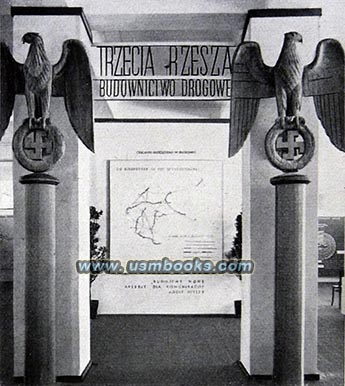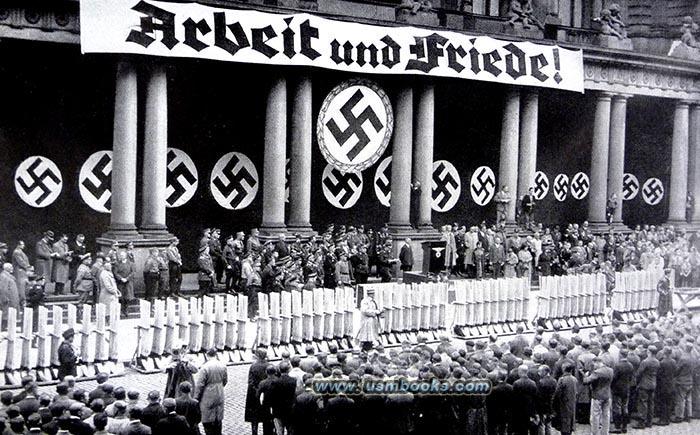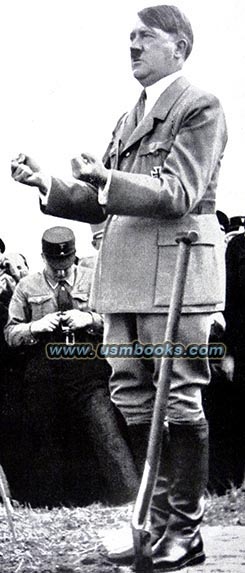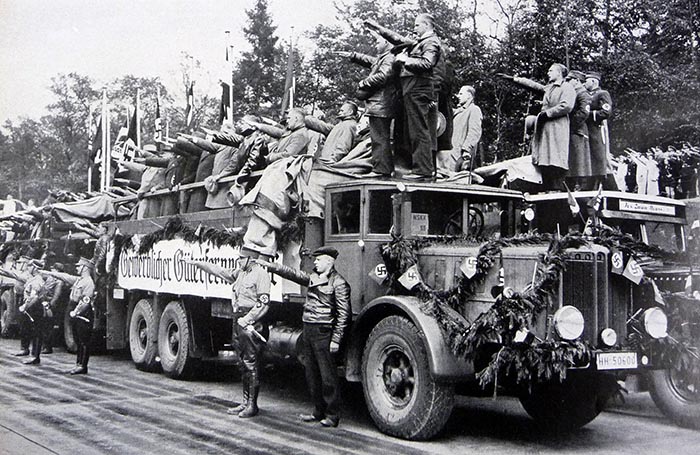DIE STRASSE MAGAZINE
|

|
ALL 1935 DIE STRASSE TECHNICAL ROAD CONSTRUCTION MAGAZINES
|
 |
| Die Strasse is a rare Third Reich magazine that was published twice monthly by order of the Generalinspektor für das Deutsche Straßenwesen, Dr. Ing. Fritz Todt (Inspector General for the German Highways). National Socialist author Friedrich Heiß was the editor of Die Strasse and many German and international experts, engineers, builders and architects contributed articles. |
 |
| Of the many subjects covered in these obscure technical Die Strasse magazines, most were related to improving streets and roads. Especially the road network of Nazi Germany, the Reichsautobahn, automobiles, motorcycles and trucks, economic aspects of road construction, road construction research and technology, road construction in mountainous terrain, the road network and trade, freeway bridge and intersection design and construction, traffic, car travel, etc. Even modern road construction details from outside Germany. |
Automobile and Motorcycle Exhibition in Berlin |
 |
 |
 |
 |

 |
1935 Highway Construction Exhibition in Warsaw attended by Dr.-Ing. Fritz Todt. |
| Reichsautobahn bridges of all kinds all over Nazi Germany are pictured, as well as the Großglockner highway, Hitler Youth boys marching, traffic jams in London and New York, plans for the Reichssportfeld in Berlin, modern steam rollers and all kinds of heavy construction equipment, the new bus station in Nice on the French Riviera, detailed construction cross sections, finishing concrete on the Reichsautobahn, camel caravans in north-west India, fire trucks, busses, motorized bicycles, motorcycles, snow removal from Munich-Salzburg freeway construction sites, a piece of the Roman road at Aleppo in Syria, a new rest stop in Westchester County USA, the raised freeway between Jersey City and Newark, alpine roads in Switzerland and Austria, the Adolf-Hitler-Pass (now called the Oberjoch Pass), the famous Mangfallbrucke east of Munich under construction, a Roman bridge in Verona (Italy), Pont du Gard near Nimes (France), the new George Washington bridge over the Hudson river, various designs of German freeway intersections, Nazi race cars, portable traffic noise measuring equipment, Fritz Todt at several construction sites, motorized police forces, freeway signage, barracks for Reichsautobahn laborers (bunks, kitchens, dining rooms), an enormous 8-wheel all terrain vehicle designed by Ing. G. Rimmek of Berlin-Siemensstadt, and much, much more. |
 |
 |
construction site on the Deutsche Alpenstrasse. Right, the famous picture of Hitler with Fritz Todt, Julius Streicher and Jakob Sprenger during the Reichsautobahn “first shovel” ceremony on 23 September 1933 at Frankfurt. |
 |
 |
Offered for sale on this USMBOOKS website is a rare heavy 7 pound hardcover book containing ALL issues of Die Strasse published in 1935, the second year in which it was published. The 9-¼ x 11-¼ inch book has 876 pages and is 1-¾ inch thick! The index for all issues is bound-in, as is the index listing the authors of articles, and an index listing articles by subject, and maps as well. |
 |
| In his Foreword, Dr. Ing. Fritz Todt wrote about the importance of Die Strassen Adolf Hitlers, the enormous scope of the freeway project, the huge number of people involved in the planning and construction and German pride resulting from so many kilometers of Reichsautobahn having been built. Todt also explained that workers should feel a sense of social responsibility by participating in and contributing to the road construction program of Adolf Hitler, “the man who deserves nothing short of perfection!” |


or all-terrain vehicle designed by Ing. G. Rimmek of
Berlin-Siemensstadt accompanied by a diagram
of the steering mechnism.

 |
a KdF event organized for Reichsautobahn workers. |
| There are also official announcements about regulations and tariffs, as well as many tables with statistics about the increase in car ownership nationally and in individual cities all over Germany, civilian car ownership in foreign countries, contrasts between German and American roads, employment numbers, different concrete mixtures, German agriculture, freeway construction costs, train vs. truck food transport, German electricity production, etc. |
 |
| Authors of articles in these 1935 Die Strasse technical magazines include Reichsminister Dr. Ing. Fritz Todt, NSKK leader Adolf Hühnlein, Dr. Leo Casagrande (Head of the Soil Mechanics Division of the Office of the Inspector General for the German Highways, who became part of the a Soil Mechanics program at Harvard University in the 1950s), Professor Paul Bonatz, Franz Ritter von Epp, Munich Mayor Karl Fiehler, Gauleiter Jakob Sprenger, Gauleiter Josef Terboven, Dipl.-Ing. Rudolf Dittrich, architect Hermann Giesler, Dipl.-Ing. Hans Suren, and dozens of other engineers and Baumeister! |



 |
| The heavily illustrated glossy pages have chapters about improving traffic laws in response to increased German car ownership, about gas stations and the increased need for gasoline, the use of concrete and steel in freeway bridges, soil stabilization, salaries of and vacation regulations for Reichsautobahn laborers, the cost of the Reichsautobahn prior to 1935, announcements about newly finished sections of the Reichsautobahn, alpine highways, freeway bridges in the United States, roads that facilitate accessibility to the Olympic Stadium in Berlin, the 1935 International Automobile and Motorcycle Exhibition in Berlin, motorized freeway police, freeway easements and drainage, ...... |
 |
| .... freeway bridge design competitions, car accidents in the USA, linking the Reichsautobahn to existing roads in and around German cities, the Deutsche Alpenstrasse (see map above), road planning in England, grocery transport using the German freeway network, technical construction challenges on the planned freeway from Munich to Salzburg, connecting existing roads in Munich to the expanding freeway network, adapting 18th and 19th century buildings to growing city traffic, the importance of modern roads for Luftschutz or Air Raid Defense forces, research into the flexibility of reinforced concrete, the national Die Strasse transportation exhibition in the city of Essen, road construction in Italy, the Reichsautobahn as a symbol of National Socialism, road construction difficulties in Poland, .... |
 |
| .... the future of the German motorized economy, the road network of India, historical finds during road excavation, laborer wage loss due to bad weather, substitute fuel for motorized vehicles, road construction in and around Warsaw, suitable living quarters for road construction crews, soil studies and road construction, bicycle travel, taking nature into consideration by fitting the freeway into the landscape, gas stations and rest stops in the USA, freeway ramps on straight and curved sections, aqueducts, road construction and soil research in Sweden, the economic importance of the Reichsautobahn for the Ruhr industrial area, night time construction on the Olympia highway to Garmisch-Partenkirchen, speed records on the Reichsautobahn, the political meaning of the Reichsautobahn, road construction exhibition in Warsaw, structural transformations and traffic, leisure time possibilities for freeway workers organized by the KdF, etc., etc., etc. |
Left, a steamlined Adler-Triumph race car on the Avus.


Volk und Reich Verlag in Berlin published Die Strasse magazine and this 90 year old hardbound book of 1935 issues was once part of the library of the Maschinenfabrik Esslingen. Their red stamp is on the front flyleaf and title page.
Maschinenfabrik Esslingen AG was an engineering company near Stuttgart that manufactured locomotives and rail cars, cable cars and cogwheel locomotives, trams, airplane tugs, ships, as well as iron and steel railway components. It was founded in 1846 and in the mid 1960s the company was bought by Daimler-Benz AG.
Maschinenfabrik Esslingen AG was an engineering company near Stuttgart that manufactured locomotives and rail cars, cable cars and cogwheel locomotives, trams, airplane tugs, ships, as well as iron and steel railway components. It was founded in 1846 and in the mid 1960s the company was bought by Daimler-Benz AG.
1935 Reichsparteitag der Freiheit,
the Nazi Party Days of Freedom
in Nuremberg
Left, the Nazi ceremony at official
opening of the important Reichsautobahn
section at München-Ramersdorf.
Below, Adolf Hitler surrounded by
high-ranking SS and NSDAP officials
at the inauguration of the expanded
Ludwigsbrücke in Munich
in November 1935.


This huge, 7 pound 876-page volume of 1935 Die Strasse magazines is a treasure trove of Third Reich German technical information. The minutia is mind-boggling and the photo content is amazing! It is in very good used condition and has no odor. This book belongs in a museum or in the collection of anyone researching or writing on these subjects and developments in Third Reich Germany.
As far as the price of this book of twice-monthly issues is concerned, it makes perfect sense since individual issues of Die Strasse can easily bring $50 each!
As far as the price of this book of twice-monthly issues is concerned, it makes perfect sense since individual issues of Die Strasse can easily bring $50 each!

 |





Also for sale on USMBOOKS.com, 1937 Nazi photo book on the
development and progress made in building with reinforced concrete,
several examples of The German Master Builder magazine as well
as many Third Reich photo books on the Reichsautobahn.
We are happy to combine shipping of multiple purchases!
for sale for $795.00 plus postage (see options below). USM book #1414 |
| • Add $16.95 for Priority Mail shipping with online tracking OR $9.95 for Media Mail. |
| • IF you wish to purchase highly recommended, but optional insurance, add $7.50. |
| • We will be happy to ship abroad at additional cost, however foreign customers are responsible for any VAT payments, import duties & customs clearing fees. Please inquire. |

 |
ceremony of the first completed section of the Reichsautobahn between Frankfurt am Main and Darmstadt. |
 |
 |
| These very rare 90 year old Die Strasse magazines are complete and in fine condition, and are filled with architectural drawings and designs, dozens and dozens of detailed maps, and hundreds of rare photos! Adolf Hitler had a great interest in expanding the road network of Nazi Germany to facilitate greater production of automobiles and trucks and is shown in many pictures. For example, he is seen during a visit to a construction site on the Deutsche Alpenstrasse, with Fritz Todt, Julius Streicher and Jakob Sprenger during the Reichsautobahn “first shovel” ceremony on 23 September 1933 at Frankfurt, at the official opening ceremony of the first completed section of the Reichsautobahn between Frankfurt am Main and Darmstadt on 19 May 1935 (above), at the International Automobile and Motorcycle Exhibition in Berlin, riding in his enormous open Mercedes-Benz car on the freeway, speaking to workers at a Reichsautobahn construction site east of Munich and with Dr. Ing. Fritz Todt during the opening ceremony at München-Ramersdorf, with Fritz Todt at the 1935 Nazi Party Days in Nuremberg, surrounded by SS men and high-ranking Nazi dignitaries during the official reopening of the rebuilt Ludwig Bridge in Munich, at the Feldherrnhalle with Putsch comrades, etc. |

